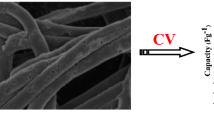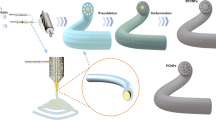Abstract
Porous carbon nanofibers were fabricated by electrospinning in a precursor solution containing polyacrylonitrile (PAN), polymethyl methacrylate (PMMA), and N,N-dimethylformamide. During thermal treatment, PMMA decomposition caused nanofibers to transform from a solid to a porous structure. Removal of PMMA also decreased the fiber diameter and increased the pore volume of the carbon nanofibers, resulting in a substantial increase in specific surface area. We used these web-type fiber films directly without a binder as an anode for lithium ion batteries. The electrochemical performance of these 5:5 PAN/PMMA-derived carbon nanofibers exhibited a discharge capacity of 446 mAh/g under a current density of 150 mA/g, which was approximately two times that of the neat PAN-derived carbon nanofibers. Additionally, the discharge capacity retention of the 5:5 PAN/PMMA-derived carbon nanofibers was nearly the same as that of the neat PAN-derived carbon nanofibers, indicating favorable cycle stability.








Similar content being viewed by others
References
Jana M, Sil A, Ray S (2014) Morphology of carbon nanostructures and their electrochemical performance for lithium ion battery. J Phys Chem Solids 75:60–67
Liu XM, Huang ZD, Oh SW, Zhang B, Ma PC, Yuen M, Kim JK (2012) Carbon nanotube (CNT)-based composites as electrode material for rechargeable Li-ion batteries: a review. Compos Sci Technol 72:121–144
Yoo EJ, Kim J, Hosono E, Zhou HS, Kudo T, Honma I (2008) Large reversible Li storage of graphene nanosheet families for use in rechargeable lithium ion batteries. Nano Lett 8:2277–2282
Sun Y, Wu Q, Shi G (2011) Graphene based new energy materials. Energ Environ Sci 4:1113–1132
Wang G, Shen X, Yao J, Park J (2009) Graphene nanosheets for enhanced lithium storage in lithium ion batteries. Carbon 47:2049–2053
Kim C, Yang KS, Kojima M, Yoshida K, Kim YJ, Kim YA, Endo M (2006) Fabrication of electrospinning-derived carbon nanofiber webs for the anode material of lithium-ion secondary batteries. Adv Funct Mater 16:2393–2397
Ji L, Zhang X (2009) Fabrication of porous carbon nanofibers and their application as anode materials for rechargeable lithium-ion batteries. Nanotechnology 20:155705
Khan WS, Asmatulu R, Rodriguez V, Ceylan M (2014) Enhancing thermal and ionic conductivities of electrospun PAN and PMMA nanofibers by graphene nanoflake additions for battery-separator applications. Int J Energy Res 38:2044–2051
Peng YT, Lo CT (2015) Effect of microstructure and morphology of electrospun ultra-small carbon nanofibers on anode performances for lithium ion batteries. J Electrochem Soc 162:A1085–A1093
Endo M, Kim YA, Hayashi T, Nishimura K, Matusita T, Miyashita K, Dresselhaus MS (2001) Vapor-grown carbon fibers (VGCFs)—basic properties and their battery applications. Carbon 39:1287–1297
Zhang L, Aboagye A, Kelkar A, Lai C, Fong H (2014) A review: carbon nanofibers from electrospun polyacrylonitrile and their applications. J Mater Sci 49:463–480
Arshad SN, Naraghi M, Chasiotis I (2011) Strong carbon nanofibers from electrospun polyacrylonitrile. Carbon 49:1710–1719
Khan WS, Asmatulu R, Ceylan M, Jabbarnia A (2013) Recent progress on conventional and non-conventional electrospinning processes. Fiber Polym 14:1235–1247
Nuraje N, Khan WS, Lei Y, Ceylan M, Asmatulu R (2013) Superhydrophobic electrospun nanofibers. J Mater Chem 1:1929–1946
Ji L, Zhang X (2009) Generation of activated carbon nanofibers from electrospun polyacrylonitrile-zinc chloride composites for use as anodes in lithium-ion batteries. Electrochem Commun 11:684–687
Lee BS, Son SB, Park KM, Yu WR, Oh KH, Lee SH (2012) Anodic properties of hollow carbon nanofibers for Li-ion battery. J Power Sources 199:53–60
Wang L, Yu Y, Chen PC, Chen CH (2008) Electrospun carbon-cobalt composite nanofiber as an anode material for lithium ion batteries. Scr Mater 58:405–408
Yu Y, Gu L, Zhu C, Aken PA, Maier J (2009) Tin nanoparticles encapsulated in porous multichannel carbon microtubes: preparation by single-nozzle electrospinning and application as anode material for high-performance Li-based batteries. J Am Chem Soc 131:15984–15985
Ji L, Lin Z, Medford AJ, Zhang X (2009) In-situ encapsulation of nickel particles in electrospun carbon nanofibers and the resultant electrochemical performance. Chem Eur J 15:10718–10722
Ji L, Jung KH, Medford AJ, Zhang X (2009) Electrospun polyacrylonitrile fibers with dispersed Si nanoparticles and their electrochemical behaviors after carbonization. J Mater Chem 19:4992–4997
Choi HS, Lee JG, Lee HY, Kim SW, Park CR (2010) Effects of surrounding confinements of Si nanoparticles on Si-based anode performance for lithium ion batteries. Electrochim Acta 56:790–796
Hwang TH, Lee YM, Kong BS, Seo JS, Choi JW (2012) Electrospun core-shell fibers for robust silicon nanoparticle-based lithium ion battery anodes. Nano Lett 12:802–807
Wu Y, Balakrishna R, Reddy MV, Nair AS, Chowdari BVR, Ramakrishna S (2012) Functional properties of electrospun NiO/RuO2 composite carbon nanofibers. J Alloy Compd 517:69–74
Chaudhari S, Srinivasan M (2012) 1D hollow alpha-Fe2O3 electrospun nanofibers as high performance anode material for lithium ion batteries. J Mater Chem 22:23049–23056
Kong J, Yee WA, Wei Y, Yang L, Ang JM, Phua SL, Wong SY, Zhou R, Dong Y, Li X, Lu X (2013) Silicon nanoparticles encapsulated in hollow graphitized carbon nanofibers for lithium ion battery anodes. Nanoscale 5:2967–2973
Ryu JH, Kim JW, Sung YE, Oh SM (2004) Failure modes of silicon powder negative electrode in lithium secondary batteries. Electrochem Solid-State Lett 7:A306–A309
Kasavajjula U, Wang CS, Appleby AJ (2007) Nano- and bulk-silicon-based insertion anodes for lithium-ion secondary cells. J Power Sources 163:1003–1039
Ji LW, Medford AJ, Zhang XW (2009) Electrospun polyacrylonitrile/zinc chloride composite nanofibers and their response to hydrogen sulfide. Polymer 50:605–612
Rahaman MSA, Ismail AF, Mustafa A (2007) A review of heat treatment on polyacrylonitrile fiber. Polym Degrad Stab 92:1421–1432
Niu H, Zhang J, Xie Z, Wang X, Lin T (2011) Preparation, structure and supercapacitance of bonded carbon nanofiber electrode materials. Carbon 49:2380–2388
Hsu YH, Lai CC, Ho CL, Lo CT (2014) Preparation of interconnected carbon nanofibers as electrodes for supercapacitors. Electrochim Acta 127:369–376
Hong CK, Yang KS, Oh SH, Ahn JH, Cho BH, Nah C (2008) Effect of blend composition on the morphology development of electrospun fibers based on PAN/PMMA blends. Polym Int 57:1357–1362
Goel SK, Beckman EJ (1994) Generation of microcellular polymeric foams using supercritical carbon-dioxide. 1. Effect of pressure and temperature on nucleation. Polym Eng Sci 34:1137–1147
Sutasinpromprae J, Jitjaicham S, Nithitanakul M, Meechaisue C, Supaphol P (2006) Preparation and characterization of ultrafine electrospun polyacrylonitrile fibers and their subsequent pyrolysis to carbon fibers. Polym Int 55:825–833
Xia K, Gao Q, Jiang J, Hu J (2008) Hierarchical porous carbons with controlled micropores and mesopores for supercapacitor electrode materials. Carbon 46:1718–1726
Fuertes AB, Lota G, Centeno TA, Frackowiak E (2005) Templated mesoporous carbons for supercapacitor application. Electrochim Acta 50:2799–2805
Lee GJ, Pyun SI (2006) Effect of microcrystallite structures on electrochemical characteristics of mesoporous carbon electrodes for electric double-layer capacitors. Electrochim Acta 51:3029–3038
Azaroff LV (1968) Elements of X-ray crystallography. McGraw-Hill, New York
Oya A, Marsh H (1982) Phenomena of catalytic graphitization. J Mater Sci 17:309–322
Dresselhaus MS, Dresselhaus G, Pimenta MA, Eklund PC (1999) In: Pelletier MJ (ed) Analytical application of Raman spectroscopy. Blackwell, London
Wang C, Appleby AJ, Little FE (2002) Irreversible capacities of graphite anode for lithium-ion batteries. J Electroanal Chem 519:9–17
Kumar PS, Sahay R, Aravindan V, Sundaramurthy J, Ling WC, Thavasi V, Mhaisalkar SG, Madhavi S, Ramakrishna S (2012) Free-standing electrospun carbon nanofibres—a high performance anode material for lithium-ion batteries. J Phys D: Appl Phys 45:265302
Subramanian V, Zhu H, Wei B (2006) High rate reversibility anode materials of lithium batteries from vapor-grown carbon nanofibers. J Phys Chem B 110:7178–7183
Kim JS, Park YT (2000) Characteristics of surface films formed at a mesocarbon microbead electrode in a Li-ion battery. J Power Sources 91:172–176
Matsumura Y, Wang S, Kasuh T, Maeda T (1995) The dependence of reversible capacity of lithium ion rechargeable batteries on the crystal structure of carbon electrodes. Synth Met 71:1755–1756
Wang S, Matsumura Y, Maeda T (1995) A model of the interaction between disordered carbon and lithium. Synth Met 71:1759–1760
Flandrois S, Simon B (1999) Carbon materials for lithium-ion rechargeable batteries. Carbon 37:165–180
Kaneko K, Imai J (1989) Adsorption of NO2 on activated carbon fibers. Carbon 27:954–955
Kang KC, Kin SS, Choi JW, Kwon SH (2008) Sorption of Cu2+ and Cd2+ onto acid- and base-pretreated granular activated carbon and activated carbon fiber samples. J Ind Eng Chem 14:131–135
Acknowledgments
This work is financially supported by the Ministry of Science and Technology in Taiwan under Grant No. 102-2221-E-006-018-MY3 and the Technology Development Program for Academia No. 103-EC-17-A-08-S1-204 by Ministry of Economic Affairs in Taiwan.
Author information
Authors and Affiliations
Corresponding author
Rights and permissions
About this article
Cite this article
Peng, YT., Lo, CT. Electrospun porous carbon nanofibers as lithium ion battery anodes. J Solid State Electrochem 19, 3401–3410 (2015). https://doi.org/10.1007/s10008-015-2976-7
Received:
Revised:
Accepted:
Published:
Issue Date:
DOI: https://doi.org/10.1007/s10008-015-2976-7




